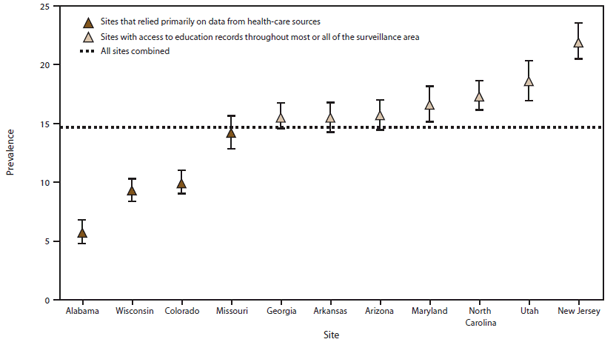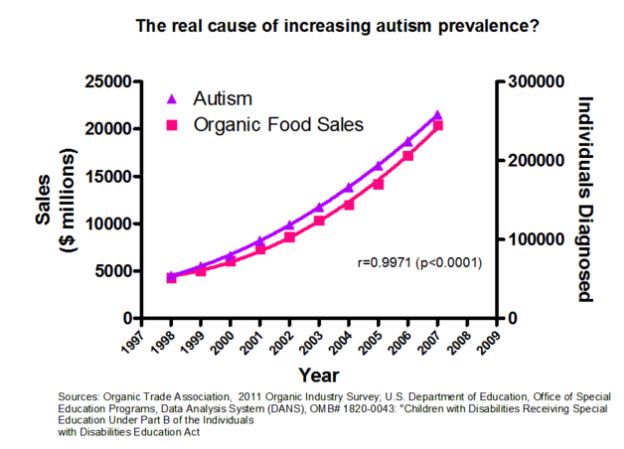That's a big jump, an epidemic even. Mainstream media is going to have a field day and everyone will be looking for ways to demonize their favorite societal targets.
Before we start writing to Congress, we need to keep a few things in mind.
(1) It's an estimate based on diagnoses
The first thing we need to realize is what the numbers mean. The CDC doesn't know how many cases of autism there are, they just estimate based on how many autism diagnoses there are. And that is not always telling us a meaningful story. An interesting study found that if you go to one area of Los Angeles, for example, you will find a true nexus of autism. Autism diagnoses up to 6X higher than elsewhere in California. Does Hollywood cause autism? No, wealthy people tend to get diagnosed with a lot more stuff and we can see it in that study, where kids who did not have autism moved there and suddenly became diagnosed as autistic. It is not an autism cluster, it is a diagnosis cluster, created by a whole lot of pediatricians who are meeting demand.
Maybe that is why 1 in 45 kids in New Jersey are diagnosed with autism while only 1 in 175 children in Alabama are.

Estimated prevalence of autism spectrum disorder among children aged 8 years, per 1,000 — Autism and Developmental Disabilities Monitoring Network, 11 sites, United States, 2010. Source: Prevalence of Autism Spectrum Disorder Among Children Aged 8 Years — Autism and Developmental Disabilities Monitoring Network, 11 Sites, United States, 2010 March 28, 2014
But, might that disparity be that kids in Alabama are under-diagnosed? Sure. If you want to engage in cultural elitism you can also claim that autism just doesn't stand out in Alabama. The CDC even gets in the obligatory shout-out to Obamacare, noting for residents of Alabama that there is now no longer a reason their children can't be diagnosed with autism the same way wealthier New Jersey kids are.
The results highlight a problem with modern epidemiology - it can mean anything people want it to mean. And it often does.
Since epidemiologists find matching data and imply causation, they can blame pesticides for increased autism. They can also blame organic food. We can find curves for both that match the increase in autism diagnoses - and that is the problem with statistics from the CDC if they are not properly calibrated.

If you just want to find two curves going the same way and imply causation, you can. That does not make it valid. Link: io9
It can also apply to any disorder that is symptom-based and subjective. It can apply to any country. It may not be that developing nations have less autism, they may not have been told they have it yet. The Implicit Association Test was not created to figure out if you are racist, but to prove you are racist even if you are not. The criteria for putting a child 'on the spectrum' is just as deterministic. If a mother says a child has behavioral issues enough, some doctor or psychologist is going to agree. And as we see in the details, a whole lot of these diagnoses are subjective behavioral claims rather than diagnostic.
So estimates based on diagnoses are not telling the complete story because
(2) It's not a nationally representative sample
The CDC funds grantees for this. It is not nationally representative, it is based on the state's ability to report on autism statistics. And they use DSM-IV for criteria, which is an important piece of data. The National Institute of Mental Health has said it will not use DSM-5 as anything more than a glossary, because DSM remains too much of a hodge-podge of symptom-based diagnoses and special interests all competing to get covered under insurance. There's little science, at least not how we understand science in the last 50 years, and a whole bunch of people who were on the autism spectrum in DSM-IV might not be under DSM-5. Once DSM is not a reference for the NIMH, it won't be paid by insurance so easily. Unfortunately, a lot of people who really need services are going to be caught up in that but they are being impacted now, because the competition for those services is being amplified by aggressive diagnoses.
The latest estimate is based on 2010 results. It included 363,749 children aged 8 years in 11 states. The prevalence was 14.7 per 1,000, which translates to 1 in 68. But the way those numbers are drawn remain inconsistent, at least if we want to create an action plan. Arizona's numbers on autism, for example, were 58% exclusively from education sources while that was only 14% in Utah.
It's not wrong, it is just that out of context, and showing up in a broad claim, like 1 in 68, it isn't helping people understand what is happening or even if anything has changed. In states that reported intellectual ability, less than 10% of kids with autism were receiving special education services under a primary eligibility category of intellectual disability. That means there were instead behavioral issues, which might range from severe to just personality variance.
The CDC lists 5 issues that might confound their estimates, but you aren't likely to see them in most coverage: Not representative; inconsistency in population denominators and 33% of the sites didn't report education statistics. The other two were relatively minor - racial definition across regions and lack of intellectual disability statistics in all sites.
And they acknowledge that the switch DSM-5 could cause the results to fluctuate a lot. Preliminary results show that autism diagnoses today would mean 31% of cases could disappear. When people are lobbying to have their kids be autistic, it makes for difficulty in providing real data. So, autism diagnoses could drop a lot in 4 years, even though nothing much may have changed.
Obviously, autism is better diagnosed but it is also sometimes over-diagnosed. Middle class white boys get an overwhelming number of these diagnoses and, overall, boys get 5X the diagnoses of girls. Are we to believe this problem is primarily in wealthy white boys?





Comments